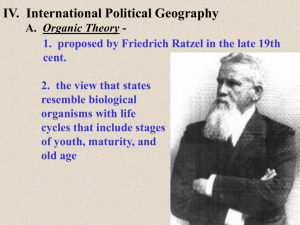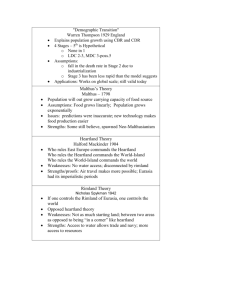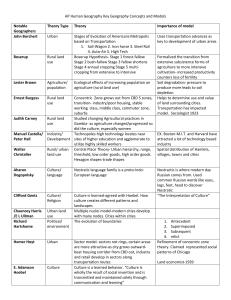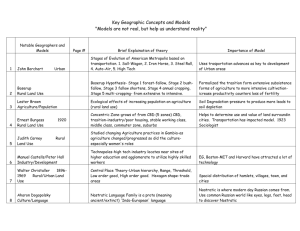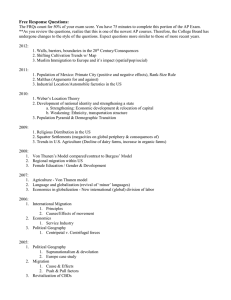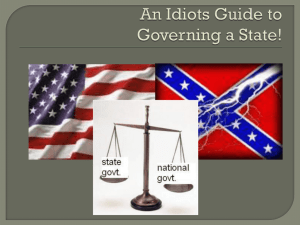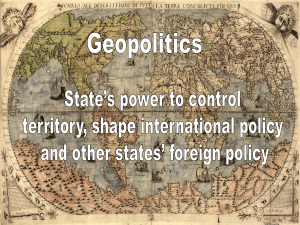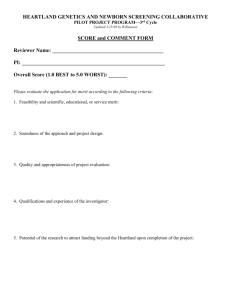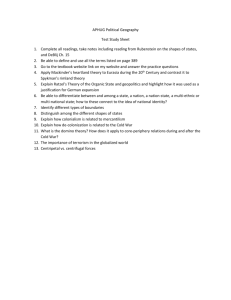Models in Human Geography
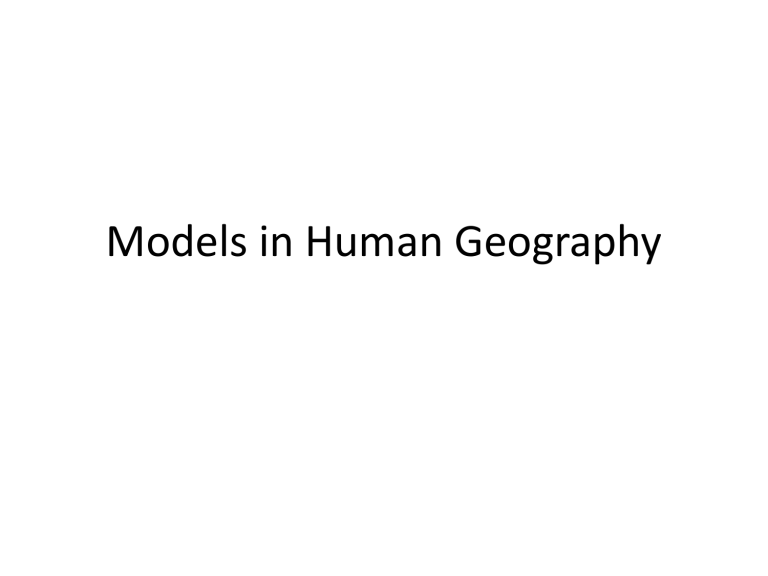
Models in Human Geography
Distance Decay Model
• Law of Spatial Interaction
• Distance and interaction are inversely proportional
• The shorter the distance the more likely interaction will occur; the greater the distance the less likely interaction occurs
• The “friction of distance” increases with distance
• Relative distance – measured in time and cost of travel; transferability
The Gravity Model
• predictor of migration flows based on size
(population) and distance between two places (2 factors, not
JUST distance)
• resembles Newton’s law of gravity based on size (mass) of 2 objects
• Gravity Model accounts for: population migration, commodity flows, work commutes, shopping patterns, telephone call volumes
Demographic Transition Model
• Generalized illustration of population change over time; prediction of growth pattern that ALL countries will follow.
• Based on European experience of population growth and then return to equilibrium as result of industrialization and urbanization
1. High, fluctuating birth; high, fluctuating death = low growth
2. High birth; falling death = high growth
3. Falling birth; continued falling death = decreasing growth
4. Low birth; low death = low growth
(zero population growth (ZPG)
Thomas Malthus – J-Curve
• World population increase would outrun the development of food supplies
– population increases geometrically (exponentially)
– food supply increases arithmetically
– formed conclusion after England became 1st country to enter Stage 2 of DTM following the Industrial Revolution
– predicted the world was heading for a crash
• Neo-Malthusians fear population growth since WWII is worse than what Malthus predicted
– Motivated institution of radical anti-natalist policies
•
•
•
• 1971 – India’s Emergency Act
China’s “One Family, One Child” policy
Indonesia’s radical Family Planning program
Widespread abortion and infanticide
Ester Boserup – S-Curve
• Boserup Thesis (Ester Boserup) –
– population increases necessitate technological advancements
– technology will always raise carrying capacity when overpopulation occurs
– revision of Malthusian Theory
– conversion from extensive to intensive
Population Pyramids
Mackinder’s Heartland Theory - early 20 th c. theory that claimed whichever state controlled the resource-rich “heartland” of Eastern Europe could eventually dominate the world. It would suggest that not the United Kingdom (an ocean-based empire), but Russia (which was becoming communist) would be in a position to achieve this dominance. "Who rules East Europe commands the Heartland; who rules the Heartland commands the World-Island (Europe, Asia &
Africa); who rules the World-Island controls the world."
Spykman’s Rimland Theory - mid 20 th c. theory that the domination of the coastal fringes of Eurasia (the “rimland”) would provide the base for world conquest (not the
“heartland”).
Rostow’s Model of Economic Development
Core-Periphery Model
• Core-periphery model: describes the pattern of distribution of the
MDCs and LDCs. When the earth is viewed from the North Pole
(azimuthal), the MDCs are clustered near the center of the map
(core) while the LDCs are near the edges (periphery).
Core-Periphery Model in US History
Von Thunen’s Model of Rural Land Use
When choosing an enterprise, a commercial farmer compares two costs; cost of the land versus the cost of transporting production to
market. Identifies a crop that can be sold for more than the land cost, distance of land to market is critical because the cost of
transporting varies by crop.
Assumptions of von Thunen:
• 1. Market-oriented gardens and milk producers in first ring, because of expense of transportation and perishability.
• 2. In the next rings wood lots used for construction and fuel; it is a heavy industry with high transportation costs.
• 3. Next rings are used for extensive crops, i.e. wheat, corn, soybeans, cotton
• 4. The outermost ring devoted to extensive animal grazing on the open range
Weber’s Least-Cost Theory
M = Market
“Weber’s Locational Triangle”
• The optimal location of a manufacturing firm in relation to the cost of transportation, labor, and advantages through agglomeration.
P= production site
S1 = raw material source #1
S2 = raw material source #2
• -Weight-loss industry: (bulk
reducing) if the finished product costs less to transport, the firm will be located closer to the raw materials to reduce cost. (i.e. lumber for paper or furniture, copper smelting, oil refining)
• -Weight-gain industry (bulk gaining) if the finished product costs more to transport, the firm will be located closer to the market to reduce cost.
(i.e. soft drink bottling, bread bakeries, auto assembly)
Profit Maximization Model – August Losch
• The correct location of a firm lies where the net profit is greatest.
• The production location will be where the difference between production costs and sales income is the greatest.
Locational Interdependence Theory
Harold Hotelling
• Hotelling's beach model: the location of industries depends on the location of other industries
(competitors); two similar vendors would locate next to each other in the middle of a market area to maximize profit (or beach/street as his model suggests).
Central Place Theory – Walter Christaller
Seeks to explain the number, size and location of human settlements in an urban system; settlements simply function as 'central places' providing services to surrounding areas
(hinterlands); organized by hexagons to eliminate unserved or overlapping market areas.
Latin American City
Model
Fig. 13-15: In many Latin American cities, the wealthy live in the inner city and in a sector extending along a commercial spine.
US Megalopolitan Areas
The BosWash Megalopolis
The Boston-Washington corridor extends over 700 km and contains about one-quarter of
U.S. population.
Models of Urban Land Use
a. Concentric Zone Model (1920s; Ernest
Burgess): based on his studies of Chicago: 1) CBD, 2)
Zone of transition (residential deterioration
& light industry), 3) Blue-collar workers,
4) Middle-class, 5) outer suburban ring; the model is dynamic (as the city grows, the inner rings encroach on the outer ones).
b. Sector Model (1939; Homer Hoyt) urban growth creates a pie-shaped urban structure due, in part, to the advancement of transportation like the electric trolley (e.g. low-income areas could extend from the
CBD to the outer edge (3)); the same is true w/ high-rent, transportation, and industry.
c. Multiple-Nuclei Model (1945; Chauncy
Harris & Edward Ullman) claimed the CBD was losing its dominant position as the nucleus of the urban area; separate nuclei become specialized and differentiated, not located in relation to any distance attribute (urban regions have their subsidiary, yet competing, “nuclei”).
d. Peripheral Model – see next page
Peripheral Model of Urban Areas
“Edge Cities”
The central city is surrounded by a ring road “beltway”, around which are suburban areas and edge cities, shopping malls, office parks, industrial areas, and service complexes.
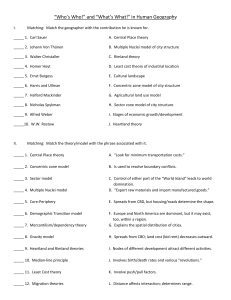
![Model_and_Theory_Chart[1]](http://s3.studylib.net/store/data/008565077_1-f7a3d3b1b3bb86c6e31ff39e95c26da5-300x300.png)
